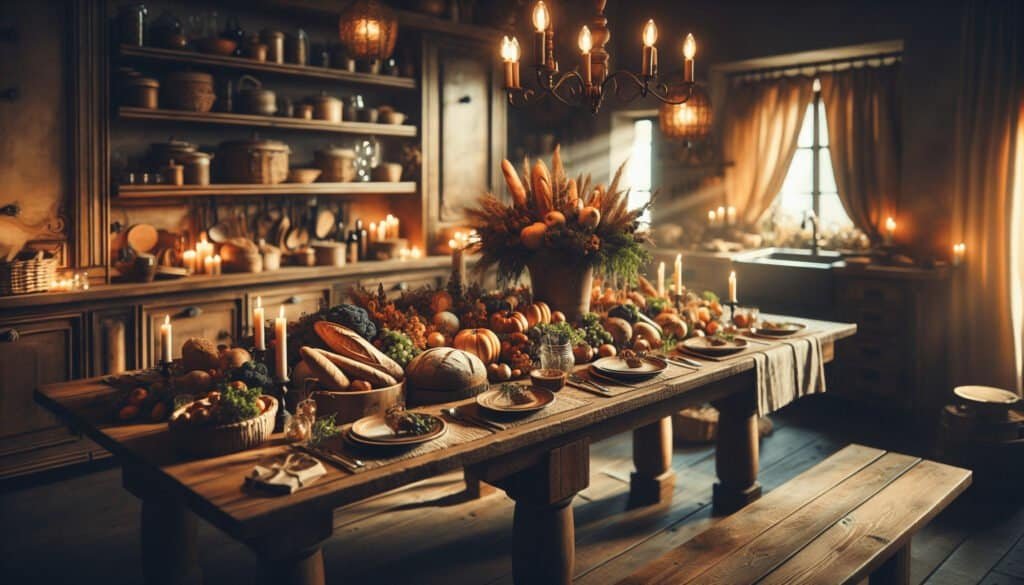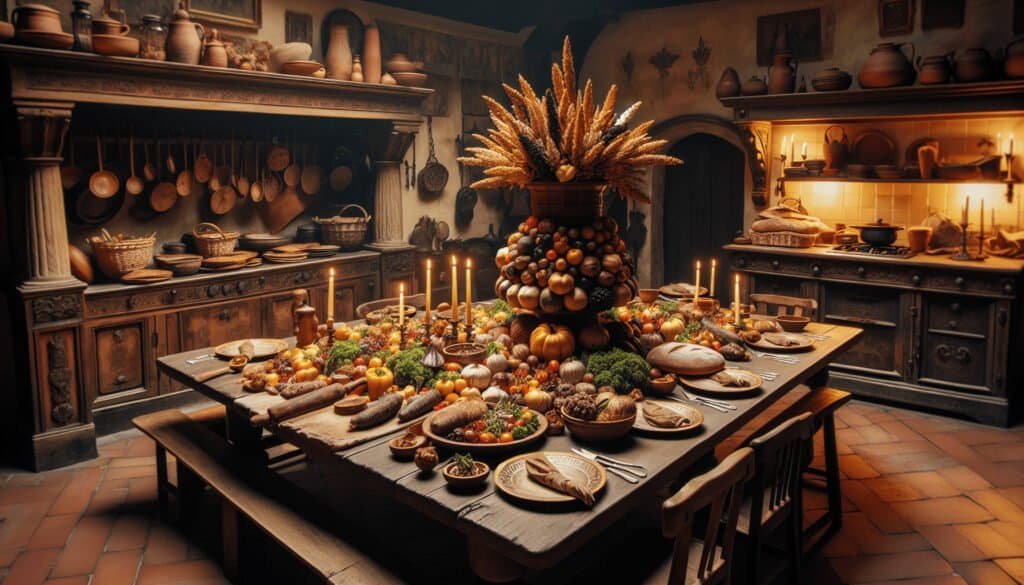Have you ever found yourself yearning for the ceremonial splendor of ancient feasts, all while grappling with the absence of a grand temple or religious edifice to serve as your culinary backdrop? The idea of preparing sumptuous meals within the confines of an ordinary space might seem daunting, yet it holds a certain charm, a touch of the theatrical. In a world rich with history, faith, and culinary mastery, you can craft your grand event, even without a temple or altar.

The Enigmatic Role of the Temple in Ancient Feasts
The temple has long stood as a focal point for gatherings, offering a sacred space where worship, food, and community converge. It’s easy to picture opulent banquets that echoed through sacred halls adorned with sacred symbols. Temples weren’t just places for prayer; they were integral to the communal experience, a synthesis of faith and sustenance.
Temples: A Culinary and Spiritual Nexus
Throughout history, temples served as more than mere structures. They were embodiments of divine presence, and the feasts held therein acted as both worship and community gathering. Think of it as an ancient version of a modern potluck, where faith, food, and fellowship blended beautifully. The biblical record is rich with descriptions of these events, showcasing the cultural and spiritual significance of temple feasts.
- Biblical Feasts: The festivals outlined in the Torah, such as Passover and Yom Kippur, were more than mere traditions; they were profound expressions of identity and faith, with food at their heart.
- Sacrificial Feasts: Offerings made at the temple often concluded with communal meals, turning sacrifice into a shared experience, reinforcing bonds among participants and with the divine.
Historical Records and Archaeological Evidence
Archaeological findings across the Near East have unearthed remnants of ancient feasting practices, from pottery fragments filled with charred remains of roasted meats to lavish table settings adorned with intricate designs. These findings paint a vivid picture of the role feasts played in establishing social hierarchies and communal bonds.
Cultures such as the Israelites, Romans, and Greeks all made food a cornerstone of their ceremonial practices, each reflecting distinct theological nuances. For example, the Roman symposium emphasized intellectual discourse accompanying lavish meals, while the Jewish Seder instilled a narrative journey centered on identity and liberation.
Preparing for Your Feast: The Modern Equivalent of Ancient Traditions
So how does one go about convening a feast worthy of the ancient times without the elaborate skills of a priest or the grandeur of a temple? The answer lies in your kitchen and, perhaps more importantly, in your heart.
Creating Your Sacred Space
While you may lack the grandeur of a temple, you can transform your ordinary space into a setting imbued with purpose and intention. Here are a few steps to set the stage:
- Choose Your Setting: Lighting is key. Use candles or string lights to create an inviting atmosphere. Emulate the soft flickering candlelight that would have illuminated ancient feasts.
- Personal Touches: Incorporate elements that reflect your identity. Use tablecloths that speak to your heritage or color palettes that resonate with your personal aesthetics. That alone creates an ambiance steeped in your unique culture.
- Themes: Just as ancient feasts followed specific themes, consider selecting a theme for your gathering. It could draw from memories or inspirations—perhaps a Mediterranean feast reflecting biblical roots or a harvest festival celebrating the bounty of the land.
Menu Planning: What Would the Ancients Serve?
Selecting menu items inspired by ancient practices can bridge the past with the present. Consider these elements:
- Whole Foods: Historically, feasts centered around fresh, locally-sourced ingredients. Try to incorporate seasonal produce, whole grains, and ethically-sourced proteins.
- Herbs and Spices: Flavorful herbs like dill, coriander, and mint were prolific in ancient cooking. Not only do they contribute to the taste but they also align with many of the culinary practices of the time.
- Sharing Plates: The communal nature of ancient feasts encourages sharing. Create dishes that allow guests to serve themselves, facilitating interaction and conversation—think of a modern-day mezze platter or charcuterie board.
Recipes Inspired by Antiquity
Recipes can enrich the feast experience, connecting you deeper to the culinary arts practiced by your ancestors. Below are simple yet delightful dishes you can prepare:
| Dish | Ingredients | Description |
|---|---|---|
| Roasted Lamb | Lamb, garlic, rosemary, olive oil | Season and roast until tender, invoking tradition. |
| Honey and Fig Salad | Fresh figs, arugula, goat cheese, honey | A sweet and savory delight that integrates ancient flavors. |
| Barley Pilaf | Barley, vegetables, spices | A staple grain in ancient diets, simple to prepare. |
| Date and Nut Balls | Dates, mixed nuts, coconut flakes | A delightful sweets inspired by ancient desserts. |
The Ritual of Gathering
The gathering of friends and family adds a layer of connection reminiscent of ancient community feasts. Encourage storytelling, just as the ancients did during their meals.
- Set the Scene: Begin with an intention or a short story about the purpose of your gathering. Perhaps you’re celebrating a milestone or reflecting on shared joys.
- Engage with Guests: Invite each guest to share a memory, a blessing, or a moment of gratitude before the meal. This practice mimics the communal prayers often shared during ancient feasts.
Reflections of Gratitude
As your gathering unfolds, take a moment to express gratitude—much like ancient people would have done in their temples. Consider sharing a brief moment of silence or saying a few words of appreciation for the meal, the company, and the shared experiences.
The Cultural and Theological Significance of Feasting
In our contemporary lives, feasting serves as a critical bridge connecting us to our cultural heritage and spiritual roots. The act of sharing meals is universally acknowledged as a form of community-building and connection.
Feasting in Religious Contexts
Across various religions, meals play a vital role in spiritual practice. Consider how communal meals occur in various belief systems:
- Passover: The Seder is rich with ritual, representing freedom and identity through storytelling and shared food.
- Eucharist: In Christianity, the act of sharing bread and wine fosters unity and remembrance of faith.
- Id al-Adha: Marking the end of pilgrimage, this feast promotes generosity and gratitude within the community.
Feasting as a Unifier
Throughout history, sharing food unites individuals, dissolving barriers and fostering understanding. Joyful experiences during a meal can cultivate relationships, nurturing love and community.
- Cultural Exchange: Gatherings often allow for the intersection of diverse culinary influences, leading to rich cultural exchanges.
- Acceptance: Ancient texts often highlight meals served to guests—a symbol of hospitality—inviting others into a shared space of warmth and acceptance.
Modern Perspectives on Ancient Practices
Now you know how to bring the ancient feast to life without the need for a temple. By taking inspiration from history and combining it with personal touches, you create a unique experience that honors the past while living fully in the present.
Culinary Practices Today
Today, the culinary world has become a melting pot of influences, producing delightful amalgams of flavors while remaining grounded in ancient practices. Chefs and home cooks alike are revisiting traditional roots, focusing less on elaborate decor and more on the simple beauty of sharing a meal.
- Farm-to-Table Movement: This movement marries sustainability with seasonality, reflecting ancient practices of using locally-sourced ingredients.
- Reinventing Tradition: Modern interpretations of traditional dishes allow you to experiment while paying homage to their origins.
Connection with the Divine
For many, food connects them with the divine. The act of preparing a meal can become a spiritual exercise, an opportunity to express gratitude and care. Through this lens, the kitchen can become your modern altar, where love and sustenance intertwine.
Balancing the Old with the New
While you might not have a grand temple, you possess the creativity and capability to blend ancient traditions with modern sensibilities. Share your meals, appreciate cultural nuances, and invite others to join the delightful tapestry of flavors you’ve woven.

Conclusion: A Feast Beyond the Temple Walls
In pondering the art of preparing feasts without the confines of a temple, you might discover that the true essence of an ancient gathering lies not just in its setting but in the love and intention that you bring.
- Connection is Key: Gatherings promote connection—between friends, family, and shared history.
- Personal Touch: Inviting creativity into your menu and space can enhance the experience and contribute to the atmosphere of feasting.
- Legacy: You’re not simply preparing a meal; you are participating in a rich tapestry of human experience, weaving together threads of culture, history, and spirituality.
It rests on your shoulders to carry forth the knowledge and skills ingrained in ancient traditions, igniting the spark of dinner table conversations that echo through time. As the aromas waft through your home and laughter dances around the table, you might just find that you’ve created your very own temple of joy and connection.


